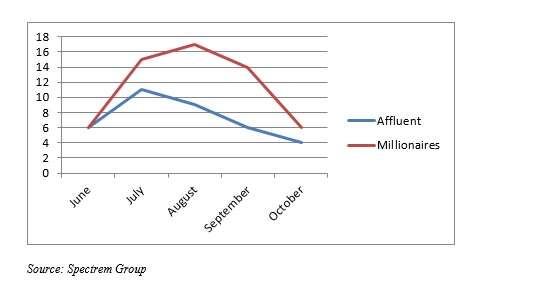 The latest Millionaire Investor Confidence Index from the Spectrem Group (SMICI) shows that the outlook both of the millionaires proper and of the mass affluent is heading down.
The latest Millionaire Investor Confidence Index from the Spectrem Group (SMICI) shows that the outlook both of the millionaires proper and of the mass affluent is heading down.
Spectrem is a strategic analyst that provides both generic and customized research for investors. The scale it employs for confidence levels ranges from a nihilistically bearish -50 to an ecstatically bullish +50, and the terrain from -10 to +10 is classified as Neutral.
By Spectrem’s definition, a “mass affluent” household has a net worth, excluding primary residence, of between $100,000 of $1 million.
The Arc Since June
On November 4th, Spectrem released the results of its surveys of both the affluent and the millionaires in October. The self-described confidence of the affluent fell from 6 to 4. The confidence of the millionaires fell more sharply, from a greater height: from 14 to 6. This keeps both groups on the ‘positive’ side of the scale, but that’s about the most positive thing that can be said about the results.
The chart below gives the index’s levels for each of the last five months.

Source: Spectrem Group
Both indexes are at roughly the level they were at back in June, after losing the gains each index made in early summer. The millionaires’ confidence rise and fall makes for an impressive arc.
George Walper Jr., the president of Spectrem Group, commenting on the results, said that the mass affluent have “consistently pointed to market conditions as the most important factor affecting their investment plans.”
By way of reminder: in May of this year the DJIA got as high as 18,300. When Spectrem was working on the June survey, the DJIA was still in that neighborhood, although closer to 18,100.
In July, markets got a couple of pieces of (at least apparent) good news. First, the Hellenic Parliament approved the measure of economic reforms that was necessary to patch Greece’s relations with the European Central Bank and to end that phase of an on-again off-again debt crisis. The country’s banks re-opened for business a few days later.
Second, at the end of July the U.S. Federal Reserve “reaffirmed its view that the current 0 to ¼ percent target range for the federal funds rate remains appropriate.”
Such developments may help account for the affluents’ confidence peak in July, and the millionaires’ much more escalated peak in August, as shown above.
Since then, though, as the Spectrem report observes, market volatility has “taken its toll” on the confidence of both sets of investors. The Greeks have given hints (at the least) that their drama may have more acts in prospect before it has played itself out. The mayor of Athens told a reporter for The New York Times, “We live in a situation of extreme urgency. We’ve become tired, and we’ve become stuck.” Meanwhile in the United States, the Federal Reserve has repeatedly backed away from the normalization of rates – and if that backing-away was once re-assuring, it now seems, well, tired and stuck.
And the DJIA fell to 15,700 in August in response to bad news from China. Though it has made up most of that ground, it hasn’t yet regained June’s levels and, even if it had the ride would have thrown a scare into even the hardiest millionaires.
Social Media
In a separate recent release, Spectrem has explained how millionaires use social media.
Among those surveyed the percentages of those who checked in at least once a day on four popular social media platforms were as follows. The column on the right shows one or more occupational group that visited each of these sites more often than the average millionaire.

As one might intuitively expect, the age of a millionaire has a good deal to do with familiarity with social media. Facebook and LinkedIn are more likely to be receiving attention from people under 35. After that age, “frequency falls off significantly.”
For twitter, though, the usage remains at a high plateau up to age 44, only then dropping off. Is there something about the requirement of concision that keeps the somewhat-older users in the fold?



